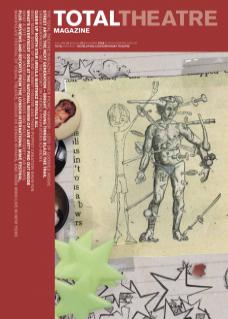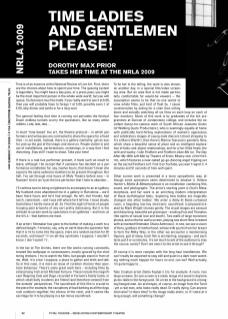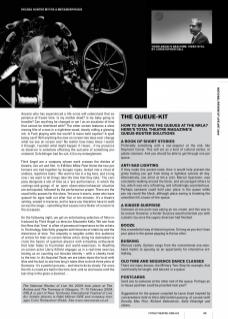Time is of an essence at the National Review of Live Art. First, there are the choices about how to spend your time. The queuing system is legendary. You might have a day pass, or a press pass; you might be the most important person in the whole wide world; but you will queue. So decisions must be made: if you really want to see X at 6.00, then you will probably have to forego Y at 5.00, possibly even Z at 4.00, skip dinner and settle in for a long wait.
The general feeling that time is running out pervades the festival. Down endless tunnels scurry the spectators, like so many white rabbits. Late, late, late…
In much ‘time-based’ live art, the theatre protocol – in which performers and witnesses are contracted to share the space for a fixed time – is set aside. Instead, there is a gallery mentality: get an eyeful, pick up the gist of the image, and move on. People clatter in and out of installations, performances, screenings, in a way that I find disturbing. Stay still! I want to shout. Take your time!
If there is a real live performer present, it feels such an insult to leave, although I do accept that if someone has decided on a performance-installation for, say, twelve hours, that doesn’t mean she expects the same audience members to be present throughout. But hell, I’ve sat through nine hours of Maly Theatre before now – in Russian! And it isn’t just the live performer that I hate to abandon…
I’ll confess now to being a nightmare to accompany to an art gallery. My husband once abandoned me in a gallery in Barcelona – we’d been there hours and he’d had enough. He left, met friends, had lunch, came back – and I was still where he’d left me. I move slowly. Sometimes I hardly move at all. So I find the sight of herds of people trooping past artworks of any sort pretty distressing. But it is the attitude to screen work by spectators in art galleries – and here, at the NRLA – that bothers me most.
If an artist / filmmaker has gone to the bother of making a work to a defined length, 7 minutes, say, why on earth does the spectator feel that it is OK to come into the space, stare at a random section for 30 seconds, and leave? TV-on-all-day syndrome I suppose. I wouldn’t know; I don’t watch TV.
In the bar at The Arches, there are film works running constantly, treated like wallpaper or screensavers, mostly ignored by the chattering drinkers. I try to watch the films, but people stand in front of me. Well, it is a bar I suppose, a place to gather and drink and talk. So in this case, it is more an issue of curation choices than spectator behaviour. There’s some great work here – including films by enterprising Irish artist Michael Fortune. These include the magnificent Reigning Cats and Dogs, recorded in Fortune’s family home, in which small daily incidents are filmed (and therefore viewed) from the animals’ perspectives. The soundtrack of this film is crucial to the piece (for example, the cacophony of loud barking as all the dogs rush outdoors together; the silence of the cats), and it seems like sacrilege for it to be playing in a bar minus soundtrack.
To be fair in the telling, the work is also shown, on another day, in a special film/video screening area. But an area that is not made particularly comfortable for would-be viewers – the assumption seems to be that no-one wants to view whole films, just kind of float by. I cause consternation by asking for a chair then sitting down and actually watching all six films on each loop on each of four monitors. Much of this work is by graduates of the MA programmes at Duncan of Jordanstone college, and includes the excellent dance-for-camera work of South African Jeanette Gislov (of Walking Gusto Productions), who is seemingly equally at home
with politically hard-hitting explorations of women’s oppression, and celebratory images of young male dancers (street stripping to It’s a Man’s World!); then there’s Marina Tsarsara’s painterly films, which show a beautiful sense of place and an intelligent exploration of body-and-object relationships; and for a fun-filled finale, the wild and wacky I Like Findhorn and Findhorn Likes Me (or, The Day After My Wife Left Me) by Theatre of Erotic Misery star JONNYREDING, which features a near-naked go-go-dancing angel tripping out on the sacred Findhorn turf. Find it on YouTube, you won’t regret it. 4 minutes and 51 seconds of time well spent.
Other screen work is presented in a more sympathetic way, although some spectators seem determined to devalue it. Helena Hunter’s Myths & Metamorphosis is an installation combining film, sound, and photographs. The artist’s starting point is Ovid’s Metamorphosis, and her work is an enriching modern interpretation of these mythological tales, ‘exploring how bodies are magically changed into other bodies’. We enter a dimly lit black-curtained room; a beguiling low-key electronic soundtrack (composed/created by Mark Wright) drones gently. The visual images are sensual and disturbing; beautiful yet grotesque – evoking Eros and Thanatos (the spirits of sexual love and death). Two walls of large monotone photos, and on the far wall a screen, playing two short films (created with acclaimed filmmaker Chiara Ambrosio). In one, we see a vision of Hera, goddess of motherhood, whose milk spurts from her breast to form the Milky Way; in the other we encounter a mesmerising Hypnos, god of sleep. Each film is enchanting, engaging – and each lasts just five or so minutes. It’s not much to ask of the audience to stay the course, surely? Don’t we owe it to the artist to see it through?
Of course it is more complex with the long-haul installations. We can’t really be expected to stay still and quiet in a dark room watching nothing much happen for hours on end, can we? Well actually, I’m quite happy to…
Take Croatian artist Zlatko Kopljar’s K12, for example. A room, two large screens. On one screen is a static image of a wood in daytime, picnic table in the foreground. On a tree in the background is a hanging/hanged man. An archetype, of course, an image from the Tarot – yet a real man, who looks really dead. Or really dying. Can anyone intervene? Is there time? Is the image really static, or if I stare at it long enough, will something change?
Anyone who has experienced a life-crisis will understand that experience of frozen time. Is my mother dead? Is my baby going to breathe? Can anything be changed or am I on an escalator of time that cannot be interfered with? The other screen features a slow-moving film of a man in a night-time wood, slowly rolling a glowing orb. A Puck playing with the world? A moon held captive? A spell being cast? Will anything the man on screen two does ever change what we see on screen one? No matter how many times I watch it through, I wonder what might happen if I leave... if my presence as observer is somehow affecting the outcome of something preordained. Schrödinger had his cat; K12 is my entanglement.
Third Angel are a company whose work crosses the divides of theatre, live art and film. In 9 Billion Miles From Home the two performers are tied together by bungee ropes, locked into a ritual of endless, repetitive tasks: ‘We want to live in a big here, and a long now / we want to let things take the time that they take.’ The company designate a slot of time as a ‘pre-performance’, in which the comings-and-goings of an open observation/rehearsal situation are anticipated, followed by the performance proper. There are the usual hefty queues for the show. Yet once it starts, some who have queued for ages walk out after five or ten minutes. It’s a theatre setting, seated in traverse, and to leave you therefore have to walk across the stage – something that causes not a flicker of concern to the escapees.
On the following night, we get an entertaining selection of films introduced by Third Angel co-director Alexander Kelly. We see from the films that ‘time’ is often of paramount importance to the artists. In Technology, Alex Kelly grapples with theories of relativity and the distortions of time. The empathy is tangible within this audience of artists for their on-screen fellow artist, doing his damnedest to crack the basics of quantum physics with schoolboy enthusiasm that later fades to frustration and world-weariness. In Realtime, on-screen actor (Jerry Killick) engages us in a real-time exercise, testing us on counting out minutes silently – with a cheeky twist to the test. In An Acquired Taste, we are taken down the local with Alex and his dad, to see how long it takes Alex to drink three pints of Guinness. It’s a painful process – and time ticks by slowly. For once, the NRLA crowd are held in the time-lock, and no one leaves until the last drop in the glass is downed…


